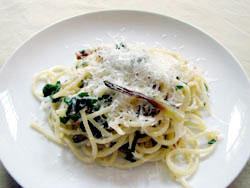The Illegal Onions That Go Great With Spaghetti

Allium tricoccum sounds like something best avoided, like some sort of infection-causing bacteria. But they are actually a rather tasty type of wild onion, better known as ramps or wild leeks. They look a lot like scallions but with deep purple stalks leading to green leaves, “taste like a balanced mixture of garlic and onion,” according to the Huffington Post, have a very pungent smell, and they go great with spaghetti. In recent years, ramps have become a trendy addition to many springtime recipes — Grub Street noted that “some people go crazy for the little wild onions” and Time Magazine dubbed these fans the “Church of the Ramp.” When it comes to ramps, the culinary world goes into a legit frenzy.
Except at restaurants in Quebec. Serving too many ramps there? It’s illegal.
A big reason why ramps are so popular is that they’re rarely in season, and even then, they’re hard to come by. Ramps, according to Epicurious, “are picky about where they grow, preferring high altitude and low light, and the second it gets hot out, they’re gone. The season lasts less than three weeks, and then they disappear as fast as they arrived.” You’ll only find them in the eastern United States and Canada, and growing them requires a lot of planning and patience; “seeds take 6 to 18 months to germinate, and the plants take 5 to 7 years to produce seeds,” again per Epicurious.
As a result, ramps can go at exorbitant prices. In 2015, for example, Eater reported that “a pound of ramps can run you $20 per pound” if you can find them, and one online service offered a five-pound box for $162. (Yes, $162 for onions.) They’re like gold, only garlicky and edible. Where there’s gold, there are prospectors, and ramps are no different. Enterprising foragers trek into the wild in search of these special onions — but many don’t take into consideration the impact of their hunt on the viability of the plant. Overharvesting of the plant in some areas, most notably the Canadian province of Quebec, has made the plant even harder to come by than it should be.
In 1995, the Quebec government responded by placing ramps (“ail des bois” in French) on its list of vulnerable plant species. As a result, it’s illegal to harvest too many ramps; if you’re caught with more than 50 bulbs (about a pound), you’re going to get a hefty fine — the law calls for a minimum penalty of $500 Canadian. And yes, the law is enforced. In 2006, according to Macleans, officers “confiscated 90,000 bulbs and charged 75 people” with poaching, and “a single picker last year was fined $10,000 for being in possession of a mind-boggling 7,829 bulbs.”
Nevertheless, ramp smugglers take their chances — because the upside is still there. As Modern Farmer reports, “Although it may seem odd that someone would risk a hefty fine for a bushel of smelly bulbs, ramps can fetch over a dollar per plant in neighboring Ontario, where the plant is legal. This has created a veritable black market in bulb smuggling as thieves pillage ramp patches throughout Quebec and carry them across the border to legally sell them at markets and fairs for a handsome profit.”
Whether ramps are worth this price is, literally, a matter of taste. But for those of us outside of the no-ramp zone, who manage to obtain some, here’s a simple but solid recipe.
Bonus fact: If you like onions and potatoes, that’s great — there are plenty of really good recipes that use both. But before you start cooking, keep them separate. Consumer Reports explains: “you don’t want is to have your potatoes and onions in close proximity, as gases from the onions can hasten sprouting in potatoes.”
From the Archives: Onion Ring: The law of onion futures.
